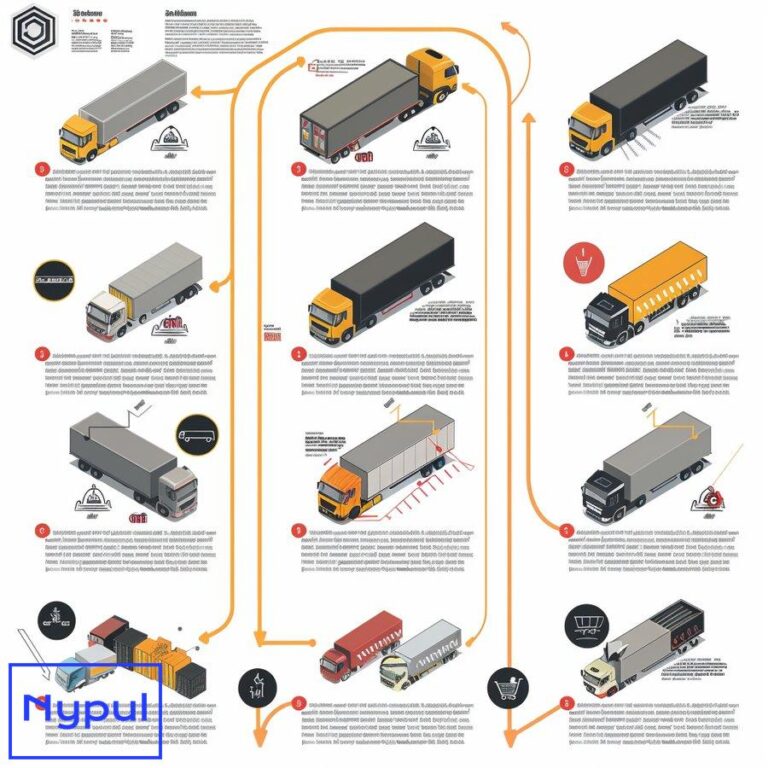What Is Effective Route Planning
What is route planning and why is it crucial for logistics?

Route planning refers to the process of determining the most efficient paths for transporting goods from one location to another. This involves analyzing various factors such as distance, traffic conditions, delivery windows, and vehicle capacities. Efficient route planning is crucial for logistics as it directly impacts delivery times, fuel consumption, and overall operational costs.
Importance of Route Planning in Logistics
-
Cost Efficiency: Effective route planning minimizes fuel consumption and reduces wear and tear on vehicles. By optimizing routes, logistics companies can save significantly on operational expenses.
-
Time Management: Timely deliveries are essential for customer satisfaction. Proper route planning ensures that goods arrive within promised timeframes, enhancing service reliability.
-
Resource Optimization: Efficient routing allows for better utilization of vehicles and drivers. This means fewer trips are needed, reducing labor costs and improving overall productivity.
-
Environmental Impact: By minimizing unnecessary travel distances, effective route planning contributes to lower carbon emissions, aligning with sustainability goals.
In summary, route planning is not just a logistical necessity; it is a strategic function that can lead to substantial improvements in cost management, service quality, and environmental responsibility.
How do you collect and analyze data for effective route planning?

Data collection and analysis are fundamental components of effective route planning. This process involves gathering relevant information about various factors that influence routing decisions.
Data Collection Methods
-
GPS Tracking: Utilizing GPS technology allows logistics companies to track vehicle locations in real-time. This data can help identify traffic patterns and optimal routes.
-
Telematics Systems: These systems collect data on vehicle performance, including speed, fuel consumption, and engine diagnostics. Analyzing this information can reveal insights into driver behavior and vehicle efficiency.
-
Historical Data Analysis: Reviewing past delivery records provides valuable insights into typical traffic conditions, seasonal variations, and common delays encountered on specific routes.
-
Customer Feedback: Gathering feedback from customers about delivery experiences can highlight areas for improvement in routing strategies.
Data Analysis Techniques
-
Geospatial Analysis: Mapping software can visualize routes and identify potential obstacles or inefficiencies. This helps in making informed decisions about alternative paths.
-
Predictive Analytics: Using historical data to forecast future conditions enables logistics managers to anticipate challenges such as traffic congestion or weather-related disruptions.
-
Cost-Benefit Analysis: Evaluating the costs associated with different routing options helps determine the most economically viable paths while meeting service requirements.
By systematically collecting and analyzing data, logistics companies can develop robust route plans that enhance efficiency and responsiveness to changing conditions.
Which technologies are revolutionizing route planning?
Technological advancements have significantly transformed route planning in logistics. Several innovative tools and systems are now available that streamline the process and improve decision-making capabilities.
Key Technologies in Route Planning

-
Routing Software: Advanced routing software incorporates algorithms that analyze multiple variables to determine optimal routes. These programs often include features for real-time traffic updates and dynamic rerouting capabilities.
-
Artificial Intelligence (AI): AI-driven solutions can learn from historical data to predict traffic patterns and suggest optimal routes based on real-time conditions. Machine learning algorithms continuously improve the accuracy of these predictions over time.
-
Mobile Applications: Mobile apps provide drivers with real-time navigation assistance, enabling them to adapt their routes based on current traffic situations or road closures.
-
Cloud Computing: Cloud-based platforms facilitate collaboration among various stakeholders in the supply chain by providing access to shared data. This enhances communication between dispatchers, drivers, and customers.
-
Internet of Things (IoT): IoT devices enable real-time monitoring of vehicles and cargo conditions. Sensors can provide data on temperature, humidity, or location, ensuring that sensitive shipments are handled appropriately throughout their journey.
The integration of these technologies into logistics operations not only enhances route planning but also contributes to overall supply chain efficiency by enabling faster decision-making and improved resource allocation.
How can route planning reduce costs and improve efficiency?
Effective route planning plays a pivotal role in reducing operational costs while simultaneously enhancing efficiency across logistics operations. Understanding the mechanisms through which this occurs is essential for businesses aiming to optimize their supply chain processes.
Cost Reduction Strategies

-
Fuel Savings: By optimizing routes to minimize travel distances and avoid congested areas, companies can significantly reduce fuel consumption. This not only lowers expenses but also extends the lifespan of vehicles by reducing wear on engines.
-
Labor Efficiency: Streamlined routing means that drivers spend less time on the road. This leads to reduced overtime costs and allows companies to allocate their workforce more effectively across various tasks.
-
Maintenance Costs: Fewer trips result in lower vehicle maintenance needs. By reducing the frequency of repairs associated with excessive driving or inefficient routing, businesses can save money in the long run.
Efficiency Improvements
-
Enhanced Delivery Times: Effective route planning ensures timely deliveries by considering factors such as traffic patterns and delivery windows. Meeting customer expectations improves satisfaction levels and fosters loyalty.
-
Increased Load Capacity Utilization: By optimizing routes based on load capacities, companies can maximize the use of their vehicles. This means fewer trips are required to transport the same amount of goods, leading to improved operational efficiency.
-
Dynamic Rerouting Capabilities: Advanced routing software allows for real-time adjustments based on changing conditions such as accidents or road closures. This flexibility helps maintain efficiency even in unpredictable circumstances.
Through these strategies, businesses experience not only cost savings but also enhanced operational effectiveness—key elements for maintaining competitiveness in a challenging market environment.
What are the key challenges in implementing effective route planning?
Despite its numerous benefits, implementing effective route planning poses several challenges that logistics companies must navigate carefully. Recognizing these obstacles is crucial for developing strategies to overcome them successfully.
Common Challenges
-
Data Quality Issues: Inaccurate or outdated data can lead to suboptimal routing decisions. Ensuring high-quality data collection processes is essential for reliable analysis and decision-making.
-
Integration with Existing Systems: Many companies struggle with integrating new routing technologies into their existing logistics frameworks. Compatibility issues may arise when trying to connect disparate systems or software solutions.
-
Changing Conditions: Traffic patterns, weather conditions, and other external factors can change rapidly. Developing a flexible routing strategy that adapts to these fluctuations is vital for maintaining efficiency.
-
Driver Compliance: Even with optimal routes planned, driver adherence is critical for success. Ensuring that drivers follow designated routes requires effective communication and training programs to emphasize compliance benefits.
Addressing these challenges involves investing in robust data management practices, fostering collaboration among teams, and prioritizing ongoing training for personnel involved in logistics operations.
How do vehicle and driver considerations impact route planning?
Vehicle specifications and driver capabilities significantly influence the effectiveness of route planning strategies. Understanding these factors allows logistics companies to tailor their approaches for optimal outcomes.
Vehicle Considerations
-
Load Capacity: Different vehicles have varying load capacities which must be considered when planning routes. Overloading a vehicle can lead to inefficiencies or legal issues related to weight restrictions on certain roads.
-
Fuel Efficiency Ratings: Vehicles with higher fuel efficiency ratings should be prioritized for longer hauls or routes with heavy traffic where fuel consumption may be elevated due to idling or stop-and-go conditions.
-
Vehicle Type: The type of vehicle (e.g., refrigerated trucks versus standard freight trucks) impacts routing decisions based on specific requirements such as temperature control or cargo handling capabilities during transit.
Driver Considerations
-
Experience Level: Experienced drivers may navigate complex urban environments more efficiently than less experienced counterparts. Tailoring routes based on driver experience can enhance overall performance during deliveries.
-
Compliance with Regulations: Drivers must adhere to regulations regarding hours of service (HOS) which dictate how long they can drive before taking mandatory breaks. Effective route planning must account for these limitations to ensure compliance while maximizing productivity.
By taking both vehicle specifications and driver capabilities into account during the planning process, logistics companies can develop more efficient routes that align with operational realities while meeting regulatory requirements effectively.
What role do time windows and constraints play in route optimization?
Time windows refer to specific periods during which deliveries must occur at designated locations. These constraints play a critical role in shaping effective route optimization strategies within logistics operations.
Importance of Time Windows
-
Customer Satisfaction: Meeting delivery windows enhances customer satisfaction by ensuring timely arrivals. Failure to adhere may result in penalties or loss of business opportunities due to unmet expectations.
-
Operational Efficiency: Time constraints necessitate careful consideration when developing routes; optimizing schedules around these windows helps minimize delays while maximizing resource utilization across deliveries.
Strategies for Managing Time Constraints
- Prioritization of Deliveries
- Assessing delivery urgency allows planners to prioritize time-sensitive shipments over others.
-
Implementing tiered scheduling ensures critical deliveries receive appropriate attention without compromising overall efficiency.
-
Dynamic Scheduling
- Utilizing technology enables real-time adjustments based on changing circumstances such as traffic delays.
-
Implementing software solutions capable of rerouting vehicles dynamically ensures adherence even amidst unforeseen challenges.
-
Collaboration Among Stakeholders
- Maintaining open lines of communication between dispatchers, drivers, customers fosters transparency around expected delivery times.
- Collaborative efforts allow stakeholders involved in logistics operations—such as suppliers—to align schedules effectively.
By strategically managing time windows within routing plans through these approaches fosters greater accountability throughout supply chains while enhancing overall performance metrics related directly back towards customer satisfaction levels achieved.
How can real-time information enhance route planning strategies?
Real-time information plays an increasingly vital role in enhancing route-planning strategies within logistics operations today—providing immediate insights into changing conditions affecting transportation decisions made throughout supply chains globally.
Benefits Offered by Real-Time Data
- Traffic Updates
- Accessing live traffic information helps identify congestion points along planned routes.
-
Adjustments made proactively based upon this data enable quicker response times when encountering unexpected delays.
-
Weather Monitoring
- Real-time weather updates allow planners assess potential impacts caused by adverse conditions (e.g., storms).
-
Adapting plans accordingly mitigates risks associated with hazardous driving environments while ensuring safety remains paramount throughout journeys undertaken.
-
Vehicle Tracking
- GPS-enabled tracking systems provide visibility into vehicle locations at any given moment.
- Monitoring progress against established timelines enables better coordination between dispatchers/drivers—ensuring adherence towards predetermined schedules established prior.
Implementing Real-Time Information Systems
To fully leverage benefits offered through real-time data integration within existing frameworks requires thoughtful implementation strategies:
- Invest In Technology
-
Upgrading current systems utilized across organizations towards those equipped with advanced analytics capabilities enhances decision-making processes significantly.
-
Train Personnel
-
Providing comprehensive training programs focused upon utilizing newly implemented technologies ensures staff members understand how best utilize resources available effectively.
-
Foster Collaboration
- Encouraging collaboration between departments involved throughout supply chains promotes seamless communication channels—ultimately leading towards improved outcomes achieved collectively across various stakeholders engaged throughout processes undertaken daily.
By embracing real-time information systems alongside proactive measures taken towards integrating these tools effectively results achieved ultimately reflect positively upon overall performance metrics established previously set forth within organizations striving achieve excellence consistently across all facets involved throughout operations undertaken daily!
What measurable outcomes can businesses expect from effective route planning?
Implementing effective route-planning strategies yields numerous measurable outcomes that positively impact businesses engaged within logistics sectors today—providing tangible benefits realized through enhanced efficiencies gained over time collectively achieved across operations undertaken daily!
Key Measurable Outcomes
- Cost Savings
-
Reduced fuel consumption translates directly into lower operating expenses incurred across fleets utilized throughout journeys undertaken regularly—leading towards increased profitability margins achieved over time collectively realized through sustained efforts made towards optimizing processes implemented consistently moving forward!
-
Improved Delivery Times
-
Enhanced adherence towards established timelines results directly from optimized routing efforts made proactively—leading towards heightened customer satisfaction levels experienced consistently throughout engagements undertaken regularly!
-
Increased Resource Utilization
-
Maximizing load capacities utilized across fleets leads directly towards improved overall productivity metrics achieved collectively across organizations engaged within logistics sectors today—ensuring resources allocated efficiently throughout processes undertaken daily!
-
Enhanced Safety Records
-
Minimizing travel distances reduces risks associated with accidents occurring during transit—ultimately leading towards improved safety records maintained consistently over time collectively realized through sustained efforts made towards optimizing processes implemented consistently moving forward!
-
Environmental Impact Reduction
- Lower carbon emissions resulting from minimized travel distances contribute positively towards sustainability goals pursued actively by organizations engaged within logistics sectors today—aligning efforts made strategically alongside broader initiatives aimed at reducing environmental footprints experienced globally across industries engaged within transportation sectors worldwide!
Through careful implementation focused upon achieving measurable outcomes outlined above reflects positively upon overall performance metrics established previously set forth within organizations striving achieve excellence consistently across all facets involved throughout operations undertaken daily!






